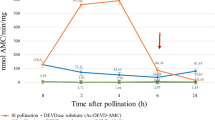Abstract
Self-incompatibility (SI) is a genetically controlled system used by many flowering plants to prevent self-pollination. We established, using calcium imaging, that the SI response in Papaver rhoeas L. (poppy) pollen involves a Ca2+-mediated intracellular signalling pathway. Here we review what is known about the signalling components and cascades implicated in the SI response in poppy pollen. We present some studies using calcium green (CG-1) that show SI-induced alterations in CG-1 fluorescence and localization. We have begun to examine potential sources of Ca2+ involved in the responses induced by SI. This work presents preliminary data showing that influx of extracellular Ca2+ at the ”shank” of the pollen tube is possible. This is the first evidence suggesting that influx at this localization may play a role in the SI response. We also describe preliminary studies that begin to investigate whether the phosphoinositide signalling pathway is implicated in the SI response.
Similar content being viewed by others
Author information
Authors and Affiliations
Additional information
Received: 12 December 2000 / Revision Accepted: 22 June 2001
Rights and permissions
About this article
Cite this article
Straatman, K., Dove, S., Holdaway-Clarke, T. et al. Calcium signalling in pollen of Papaver rhoeas undergoing the self-incompatibility (SI) response. Sex Plant Reprod 14, 105–110 (2001). https://doi.org/10.1007/s004970100092
Issue Date:
DOI: https://doi.org/10.1007/s004970100092




